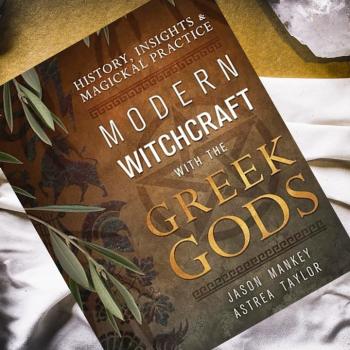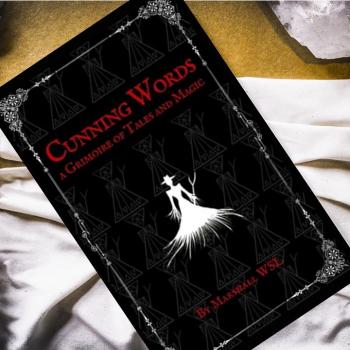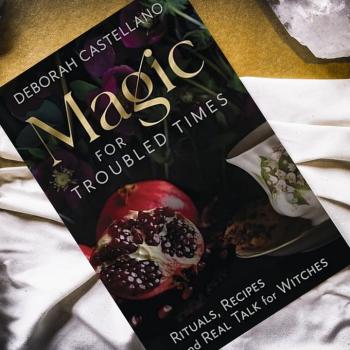Of all the festivals of the Pagan year, Imbolc, February 2, is the most complex, the most mystical. Like the other three “Cross Quarter” days (Beltain, Lammas and Samhain), Imbolc is a festival of fire, but the fires it kindles are not quite of this world.

The Lady is invoked at Imbolc as Brigid, or Bride (pronounced “Breed” in the Irish). She has always been a most beloved figure of Celtic paganism. During the long conversion to Christianity, it was said that, having Brigid, the Irish did not need Mary. Brigid was held by most Irish to have been the foster-mother of Christ. Unable to extirpate the worship of Brigid, the medieval churchmen canonized an abbess of the same name and made Imbolc her name-day. She was renowned for piety (of course), but also for learning, for healing, and for taking no nonsense from men. Folk tales of St. Brigid include her outwitting a king who tried to cheat her out of land he’d promised for the building of an abbey, and out-debating St. Patrick himself when he tried to tell her what she could and could not do. Legends also say she could turn her bath-water into beer! Like her namesake, St. Brigid is associated with fire, with holy healing wells, and with the symbol of the equal-armed Celtic cross.
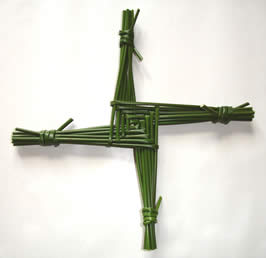
There are three aspects to Brigid, who was herself one of three Personalities of the Goddess in Irish myth: Brigid, Dana and Morrigu. There is Brigid of the Smiths, Brigid of the Healers, and Brigid of the Poets. Smithcraft, healing and poetry were all considered manifestations of fire by the Celts, and of the three, poetry was the most powerful, being highest on the ascending levels of material, mental, and spiritual.
Brigid of the Smiths was patroness of those who crafted the star-metal, iron. The transmutation of raw ore into iron and iron into artifacts was an alchemy of the deepest and most secret sort for many centuries, and its practitioners were mighty magicians. Their power also expressed itself as extreme sexual vigor, and many bawdy British folk songs, like “The Coal-Black Smith” and “The Two Magicians” can be traced back at least as far as the Saxon Smith-God, Wayland. Shape-changing also figures in smith-lore, as is appropriate to those who create in the material realm, and to Brigid, the Lady of many transformations. By extension, Brigid’s patronage of smiths extends to other artificers, especially those who make useful rather than purely artistic things.
Brigid of the Healers is still quite well known, not only in literature but in the lives of generations of Irish countryfolk. According to Stewart and Janet Farrar, who lived in Ireland, the country people still leave rags and ribbons tied to the bushes around Brigid’s holy wells as an offering for healing. That a goddess of fire should also be associated with water (specifically wells) seems strange until we recall that for millennia most medicines were home-brewed herbal concoctions. Fire and water married in their making, but it was intelligence ¾ mental fire ¾ which made the difference between a healer and an accidental poisoner.
Brigid of the Healers is also called Bride, as such She is invoked on Imbolc to bring fertility to the slowly awakening earth. The transformation from Healer to Bride comes through the process of logical extension: healing = life = fertility (more life).
All over the world, Bride images were (and are still) made of grain in the stalk, or of reeds, and are dressed as for a wedding and “put to bed.” A male image such as a club or sword may be put to bed with the Bride, or a door may be left ajar so that the Bridegroom may come to Her. According to the Farrars, quoting still other writers, this rite is still considered indispensable in isolated parts of Ireland and Scotland.
Bride seems almost to form a fourth aspect to the traditional Triple Goddess: She starts the Rite as the Maiden but at its end She is still not quite the Mother. She is the Bride, a state which is caught out of time during the process of transformation, which partakes of both Maiden and Mother but is neither. Like Her own fire (a hearthfire this time), Her power is real and tangible, but She Herself, ever changing, cannot be touched.
Brigid of the Poets is the most untouchable of all. In Her the fire burns with the cold ferocity of dry ice, the chill radiance of the stars. This is Robert Graves’s “Leprous White Lady,” beautiful, willful, demanding, yet rewarding to the poet whose verses do Her honor. She is the nine muses rolled into one Muse, the Triple Goddess in one Person, showing now this aspect, now that, at Her own choosing. Her fire enflames the soul, Her image is that deepest ideal which alternately lures us and drives us onward to our artistic and spiritual goals. She rewards us with incredible sweetness when we meet Her expectations, yet She demands our very best, always, and greets our failures with icy scorn and the expectation that we get up and try again. But even She does not demand the impossible. She demands each person’s best, but understands that that “best” can never be as perfect as She is. It is the striving that makes one worthy of Her, not necessarily the reaching of the goal. Read W.B. Yeats’s “Song of the Wandering Aengus” to understand the power of Brigid the Muse. “I went out into the wood”, he writes, “because a fire was in my head…” A perfect description of a poet, a crafter of spiritual fire, with writer’s block.
Imbolc has other facets, and other names, besides Brigid. The names “Lady Day” and “Candlemas” have been adopted by Pagans from the Christianized versions of the Sabbat. They sound pretty and convey a fine sense of what the holiday is all about. As Candlemas, however, the ritual centers on the growing light, and features the beautiful “Lucia Crown.” Candlemas is custom-made for family Paganism.
St. Lucy’s Day is primarily celebrated in Scandinavia. It was originally held at about February 1, but has been moved closer to Christmas, possibly because Christmas, too, is a festival of light, and possibly because of all the strange changes the calendar went through during the Middle Ages and Renaissance. On St. Lucy’s Day the youngest girl in the family (i.e. the “maiden of the house”) rises before dawn and, wearing a long white gown and a coronet of lighted candles, takes breakfast in to her parents in bed. There is a hokum legend to explain the custom, about a maiden named Lucy or Lucia who was canonized for her filial piety, but almost everyone recognizes that Lucia is far older than Christ .
The name Lucia is a feminine form of the Latin word for light, lux. We can see, then, that the festival of St. Lucia is all that remains of an ancient mystery play. The virgin maiden plays the personification of the principle of light which, while growing, is still very young at this time of year. She brings food to her parents to show that the new grows out of and honors the old, and she brings specifically breakfast (break-fast) to show that the winter famine will soon be over. And she comes gowned in white for purity and crowned in living flame, to show that all things have been renewed, all souls reborn from the winter’s dark womb to the light of the sun and stars.
Imbolc, like most things in Pagan theology, is part of a pair of opposites. Imbolc is the opposite, the “anti-twin”, of Lammas. They imply each other as surely as “heads” implies “tails.” For a moment, let’s consider Lammas.
Lammas, occurring on August eve, is the first of three great harvest festivals, as Imbolc is the first of three fertility rites. In most areas, though, about the only things being harvested yet are table vegetables and hay. The grain crops, about which so much harvest lore is entwined, are still green. Yet here we have songs and rituals insisting that “John Barleycorn must die”, and myths of the death of Liew Llaw Gyffs, and some pretty graphically bloody tales to back it all up. Why?
Because each pole of a dyad contains the germ of its opposite.
Our Lady is not just the Goddess of life and death, but of “Life-in-Death and Death-in-Life”. In the midst of seemingly inexhaustible life and boundless plenty, at Lammas, we are reminded that death is. It keeps us humble before the miracle.
So it is with Imbolc. February is just about the coldest, windiest, rottenest time of the year. Yet in the midst of ice and seeming death, we are reminded that life is. Tentatively, delicately, the crocuses push their pale-green spears through the ice and frozen earth; tentatively, inexorably, the dawn comes earlier and earlier. It keeps us joyful before the miracle.
Celebrating Imbolc is an act of faith. It is a saying to the Lady, and to ourselves, “I believe in Spring; I believe in the Light; I believe that the good times will come once more.” Celebrating Imbolc is a promise to yourself and to the Goddess to manifest Life and Light , whether by the arts of the Smith, the Healer, or the Poet.
And by our will, SO MOTE IT BE.
Lucia Crown
To make a Lucia Crown, lay a strip of masking tape face up on a table. You might want to pin it down every so often to keep it from wiggling while you work with it. Now take from five to thirteen birthday candles (one for each year of the girl’s age is nice) and stick them to the tape with the bottom of each candle even with one edge of the tape and the rest of the candle laying across the tape and over the other side.
Now take more tape ¾ several short lengths will work better than one long one ¾ and cover the candles and all the exposed sticky tape. You now have a candle and tape “sandwich” that can be trimmed to the size of the little girl’s head and secured at the back with more tape. Cover her head with plastic wrap to keep the wax out of her hair, and be sure to secure everything with lots of bobby pins.
Irish Soda Bread
Irish soda bread, a delicious scone-like loaf, is traditionally baked in the shape of the Celtic Cross, sacred to Brigid.
| 2 C. unsifted flour (all white or half whole wheat) 3 T. sugar ½ tsp. salt 2 tsp. baking powder 1 tsp. baking soda 3 T. butter, softened 1 C. buttermilk |
Optional Ingredients Currants; or raisins; or chopped dried fruit; or caraway seeds |
- Preheat the oven to 375°; grease a small baking sheet.
- Combine all dry ingredients, tossing with a fork to blend.
- Cut in the butter until the whole thing looks sort of like cracker crumbs; add any optional ingredients now, to taste.
- Add the buttermilk and mix with a fork just until blended.
- Turn out onto a lightly floured board. Knead gently just until smooth and elastic; this will only take a minute or two.
- Form the dough into a disk about 1½” thick and transfer gently to the baking sheet.
- Flour a large knife. Press it into the dough about halfway through; repeat, at right angles to the first cut.
- Bake for 30 to 40 minutes, or until the crust is golden brown and the loaf sounds hollow when thumped.
- Remove to a wire rack, lightly butter the top while still quite warm, and serve either slightly warm or at room temperature. With hot, strong tea, of course.
References
- The White Goddess by Robert Graves
- Dea Nymphae Brigantiae byColin Murray
- Eight Sabbat for Witches by Stewart & Janet Farrar
- The Feast of Brighid by The Fellowship of the Four Jewels (Aodh Ruad & Meadhbh)
- The Celtic Twilight by W.B. Yeats
- Hy Breasel Coven

Patheos Pagan on Facebook.
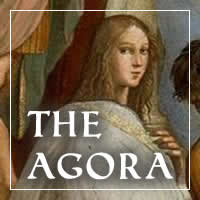
the Agora on Facebook
The Rantin’ Raven is published on alternate Saturdays here on the Agora. Subscribe via RSS or e-mail!
Please use the links to the right to keep on top of activities here on the Agora as well as across the entire Patheos Pagan channel.





